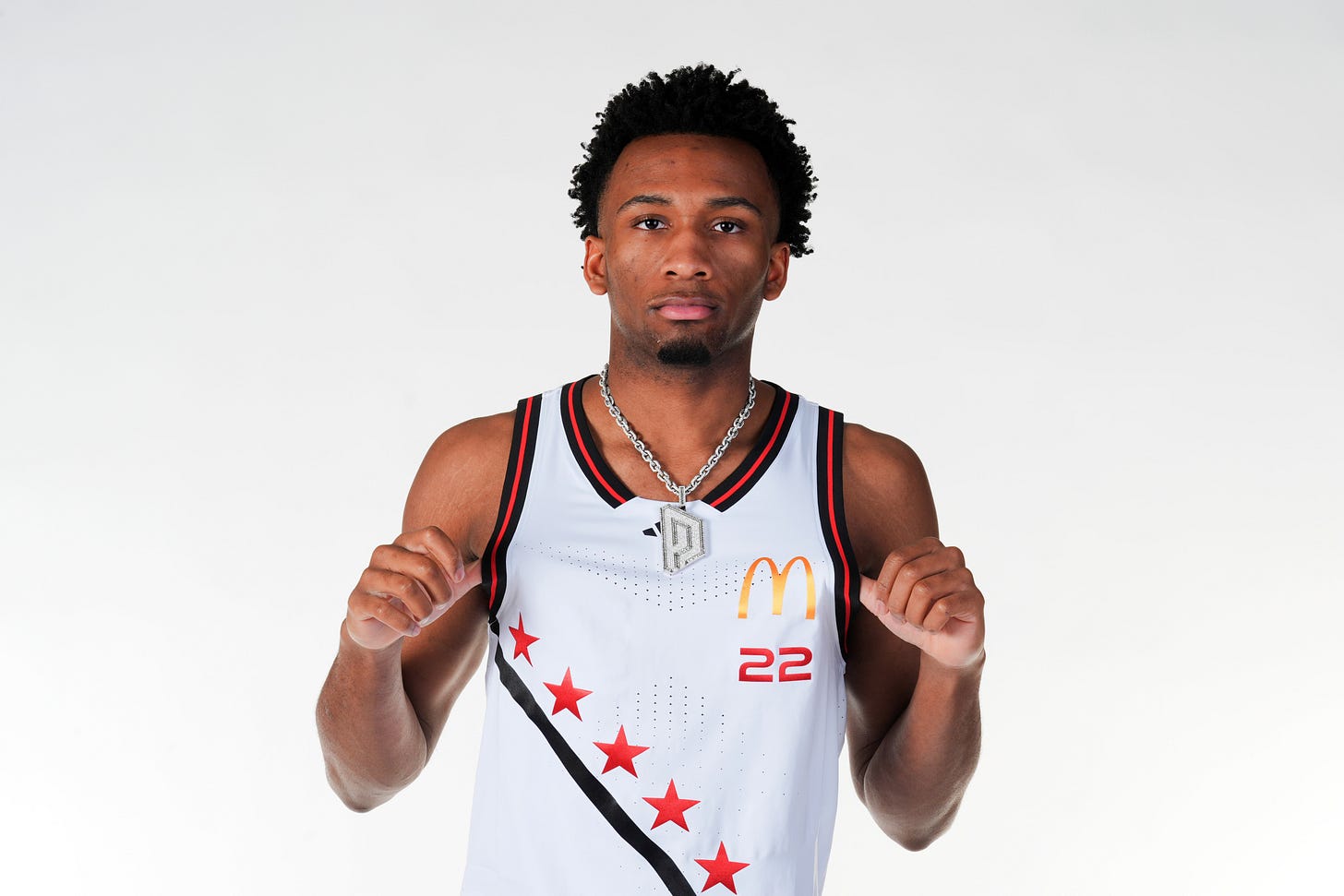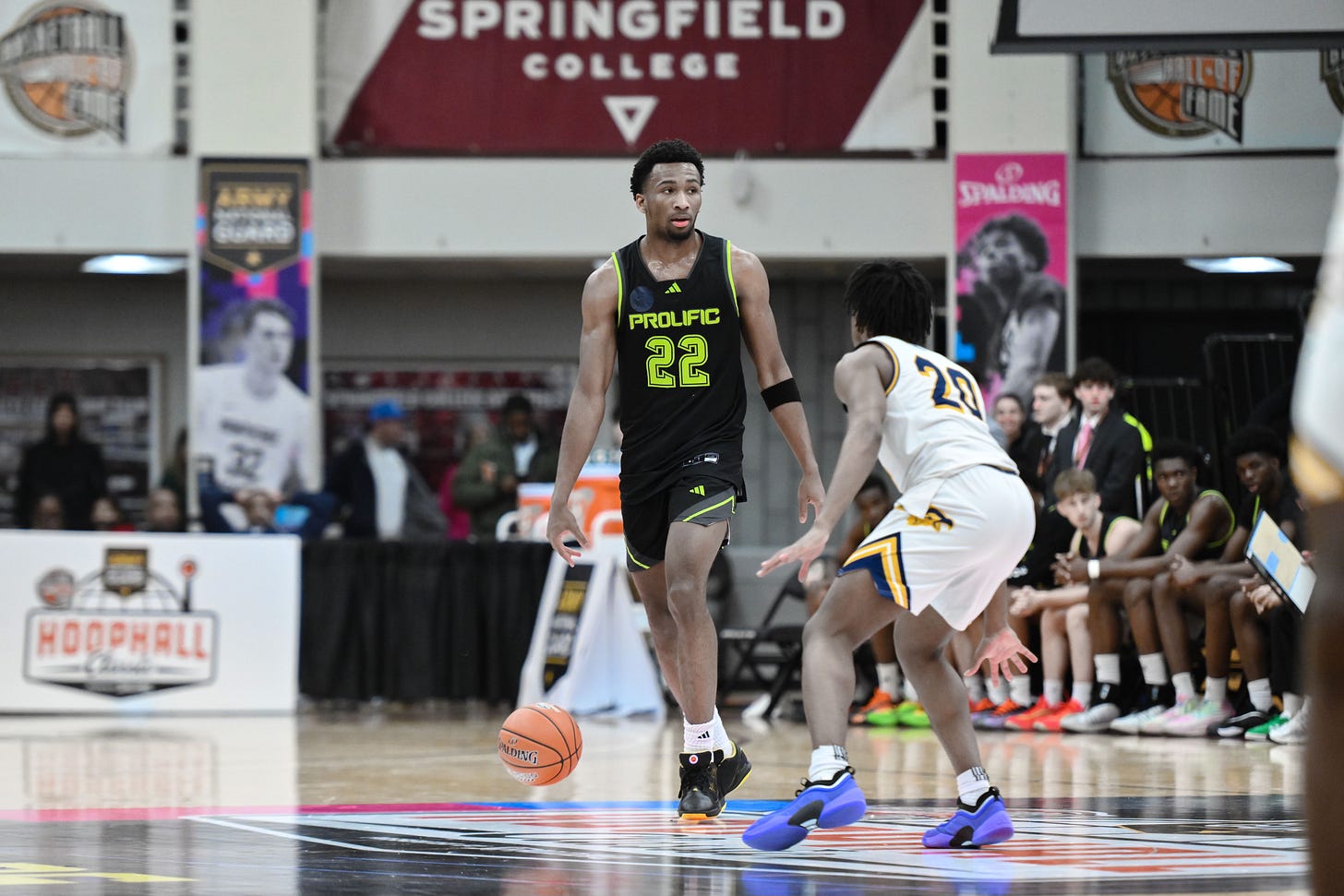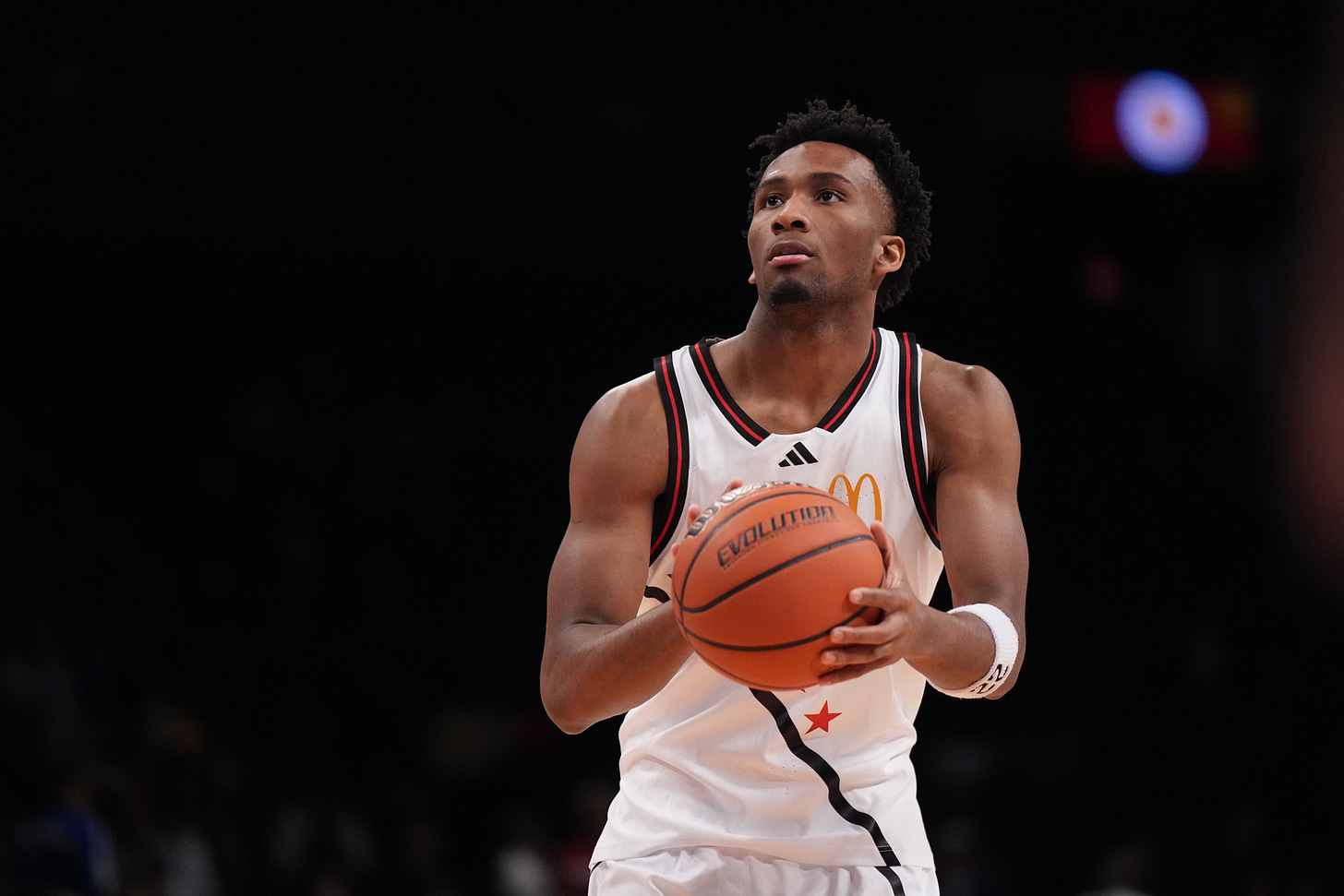Darryn Peterson, the Best Guard Prospect Since…
High Expectations, High Usage, and a Race for No. 1
When Bill Self speaks highly about a prospect, we have to listen. Self has won two national championships, made four Final Four appearances, and has been inducted into the Naismith Memorial Basketball Hall of Fame. He recruited and coached both Andrew Wiggins — the No. 1 overall pick in the 2014 NBA Draft — and Joel Embiid, the No. 3 pick in that same draft and the 2023 NBA Most Valuable Player, who, regardless of where you stand on his career, is firmly in the conversation as one of the most dominant players in NBA history.
Embiid’s résumé is loaded: MVP, fourth all-time in career points per game, seven-time All-Star, five-time All-NBA, three-time All-Defense, and two-time scoring champ.
And yet, with all that Embiid has accomplished, Self said Darryn Peterson is the best player he’s ever recruited.
“To me, Darryn’s the best player we’ve recruited since we’ve been here. When you talk about a player and a combination of a player and a prospect, I think that’s without question. He’s a specific talent.”
The superlatives haven’t stopped with Self. I’ve seen Peterson compared to Kobe Bryant. I’ve seen people call him the best guard to enter college basketball since Derrick Rose. There’s a real case he’s the best prospect in the sport right now.
Despite not having played a single minute of college basketball, Peterson’s combination of skill, athleticism, and work ethic has already drawn comparisons to NBA Hall of Famers. Fittingly, he grew up in the shadows of the Pro Football Hall of Fame in Canton, Ohio — and now looks to follow fellow Canton native C.J. McCollum, a 13-year NBA veteran, into the association after one year at Kansas.
While fellow projected No. 1 overall candidates AJ Dybantsa and Cameron Boozer have been fixtures on the national radar for years — both long regarded as the top of their class and early favorites for the No. 1 pick — Darryn Peterson’s rise has been more gradual and came with less early hype.
He announced himself as a freshman at Cuyahoga Valley Christian Academy, averaging 26.1 points, 10.5 rebounds, and 5.8 assists per game. As a sophomore, he elevated his production to 31 points, 9.8 rebounds, 2.8 steals, and 1.3 assists per game, indicating that his success was the start of a sustained climb, not a flash in the pan. His journey took him from CVCA in Ohio to a season at Huntington Prep in West Virginia, and finally to a dominant senior year at Prolific Prep in California — where he earned Naismith Prep Player of the Year honors, was named McDonald’s All-American Co-MVP, and secured a spot as a first-team Naismith All-American.
The crown jewel moment of his senior campaign came in February during a Grind Session matchup in Atlanta — a much-hyped duel against Dybantsa that doubled as a preview of a potential long-term rivalry. Peterson scored a Grind Session record 61 points that night, putting on an outrageous shot-making display. He led Prolific Prep to an 88–86 win over Dybantsa’s Utah Prep, adding 7 rebounds, 5 assists, and 3 steals to his scoring outburst. Dybantsa, for his part, poured in 49 points with 9 rebounds, 3 assists, and a steal.
It was the type of game that builds legends — two projected top picks trading haymakers in front of a charged crowd, with every possession feeling like a heavyweight round. That night in Atlanta didn’t just add to Peterson’s résumé; it planted the seeds for a rivalry that could spill over into the Big 12 next season and eventually carry into NBA debates come draft night in 2026.
In this segment from an upcoming episode of their NBA Draft podcast, Rafael and James Barlowe break down the buzz surrounding Darryn Peterson, the elite Kansas-bound guard from the class of 2025 and a projected top pick in the 2026 NBA Draft.
The Tools, the Fire, the Future: A Closer Look at Darryn Peterson
When I study Darryn Peterson’s film, the first thing that stands out is that he’s a dog — and yes, I know the term is overused, but with Peterson it’s earned. He exudes competitive fire. He’s an alpha, relentless yet composed, with an exceptional motor. He plays extremely hard, moves differently than everyone else on the floor, and has that extra gear that separates elite athletes. His first step is lightning quick, and he can shift into a top-end burst that makes defenders look stuck in place. He’s a bouncy athlete who’s tough to contain in ball-screen actions, a skill that will only be amplified by NBA-level spacing.
Peterson is a three-level scorer who loves to get to his pull-up, with the threat of his first step creating clean mid-range looks. His speed is controlled — he changes pace, changes direction, then explodes again — and his aggressive drives consistently get him two feet in the paint. That pressure at the rim not only generates free-throw attempts but also forces rotations, opening up drive-and-kick reads. Once he gets to the cup, Peterson can score in a variety of ways.
He’s comfortable scoring with either hand, using soft touch non-dunk finishes, floaters and showing excellent body control to convert through contact or in traffic. And when he gets a clean runway, he’s more than capable of delivering highlight-reel dunks that ignite the crowd and swing momentum.
Peterson’s scoring feel is evident in his deep bag of moves — hesitations, stutter steps, spins — and his confidence to hit difficult shots. When he finds a rhythm, he can string together points in rapid bursts.
If there’s an area to monitor, it’s his tendency to drive into congested lanes without fully recognizing the second line of defense. His catch-and-shoot reliability is another question mark; we know he’s dynamic on the ball, but if he’s asked to play off it more often, that’s a skill that will need to prove consistent.
The Pressure, the Platform, and the Potential
Peterson is one of the biggest reasons I’m beyond excited for the 2025-26 college basketball season. From a draft standpoint, this year should deliver a legitimate race for the No. 1 pick with Peterson, Dybantsa, and Boozer as the early frontrunners, while Tennessee’s Nate Ament, Louisville’s Mikel Brown, and Kentucky’s Jayden Quaintance could also push their way into the mix.
What makes Peterson’s year especially intriguing is the role he’s expected to play at Kansas. Bill Self has made it clear — this roster needs Peterson to be the guy.
That means a high-usage role from day one, the kind of freedom and on-ball reps that will let him fully showcase his talent, unlike other top freshmen who’ve had to fit into smaller roles. Self even admitted he’s never had a freshman quite like Peterson: Wiggins wasn’t given this much responsibility, Embiid wasn’t asked to carry the offense, and Josh Jackson had the veteran backcourt of Frank Mason and Devonte’ Graham to lean on.
It’s a sharp contrast to what we saw with last year’s VJ Edgecombe, who still ended up being the third pick in the 2025 NBA Draft but, in my opinion, was held back at Baylor. He didn’t have the same role or on-ball freedom that he enjoyed representing the Bahamas at the Olympic qualifiers last summer, where his skill set popped in a way it rarely did in college.
We even got a glimpse of his full potential in Summer League when he wasn’t playing out of position — dropping 28 points in a game with the ball in his hands. Peterson’s situation at Kansas should be the opposite — designed to give him maximum freedom to show his elite talent in the best possible context.
From a numbers perspective, Self has made it clear Peterson should be able to put up big stats. For me, the gold standard for freshman production is Trae Young’s 2017–18 season at Oklahoma, when he averaged 27.4 points and 8.7 assists — still, in my opinion, the most underrated freshman season in college basketball history.
I’m not saying Peterson will post those exact numbers, but it wouldn’t surprise me to see him in the neighborhood of 20 points and 5 assists. And honestly, even that might be underselling what he’s capable of doing.
Kansas hasn’t made it out of the first weekend of the NCAA Tournament since winning the national title in 2022, and last season ended with a first-round loss to Arkansas. The plan now seems simple: ride Peterson as far as he can take them.
With that opportunity comes immense pressure, amplified by the modern draft cycle and the nonstop noise of social media. Every couple of years we hear about the “best guard prospect in decades” — from Scoot Henderson to Jalen Green — and every performance is magnified, good or bad.
But if Bill Self believes Peterson can handle both the hype and the responsibility, I’m betting on him too.
Raw Scouting Notes
Strengths
Dog! Competitive. Alpha.
Relentless but calm
Excellent Motor
Moves different
Has a different gear he can get to
Lighting quick first step - blows by defenders
Explosive bouncy athlete
Tough to stop out of ball screens
Speed will make him dangerous w/ NBA spacing
Loves to shoot the pull up.
Threat of first step creates open middies
Controlled speed
Changes speeds and direction with ease
If he were a car, he’d be a Porsche 911
Draws fouls with his aggression
Good drive & kick vision
Can consistently get in the paint and draw 2 defenders
3 level scoring potential
Shifty handle
Finishes w/ both hands
Natural scoring instincts
Plays w/ a bounce to his step
A bag full of Hesi’s, stutter steps & spin moves
Tough shot maker
Excellent body control
Capable of getting hot and scoring in bunches
Crazy efficient finisher at rim
High conversion of non dunk finishes
Concerns
Drives into congested lanes
Can he shoot off the catch?




